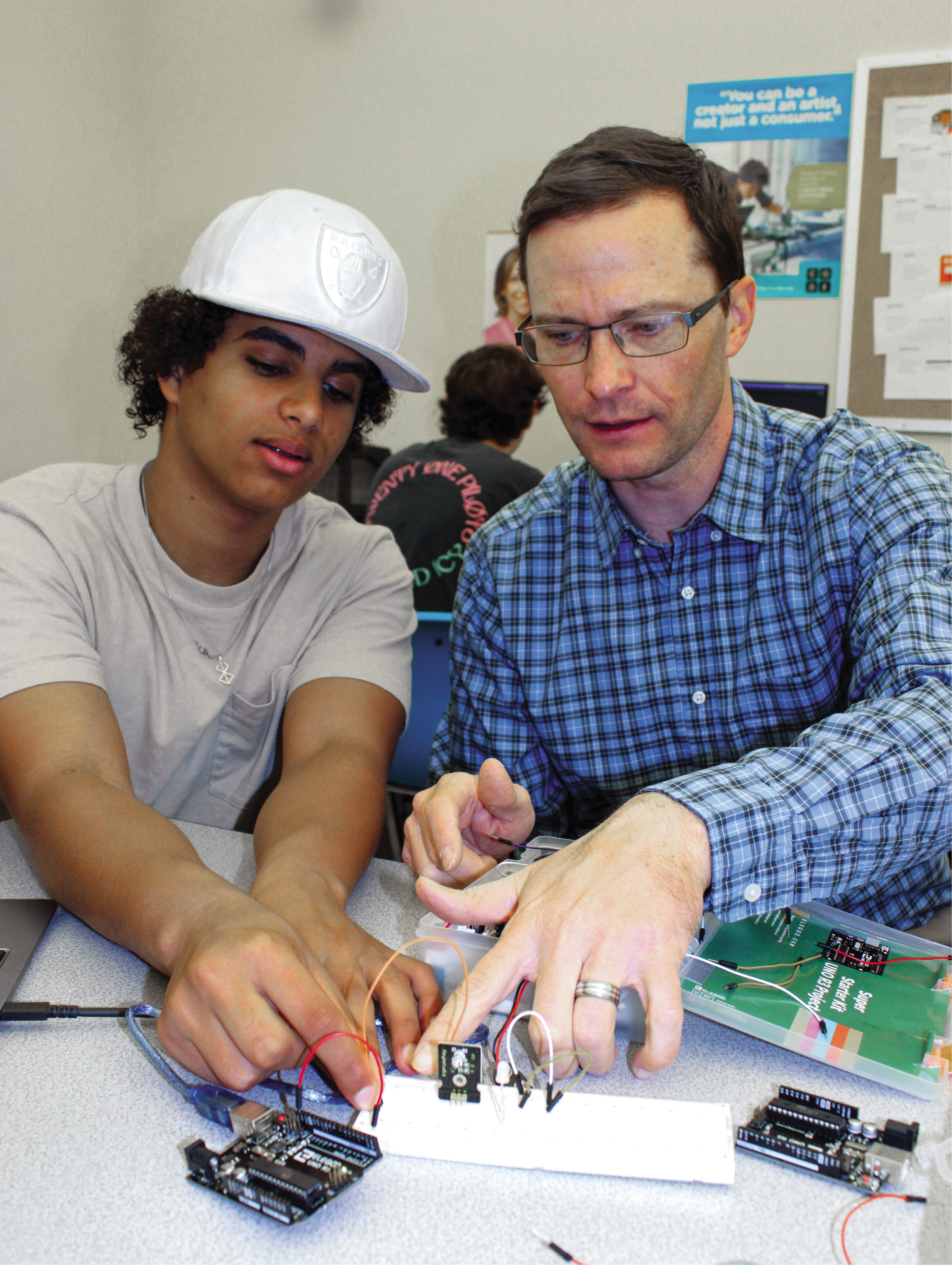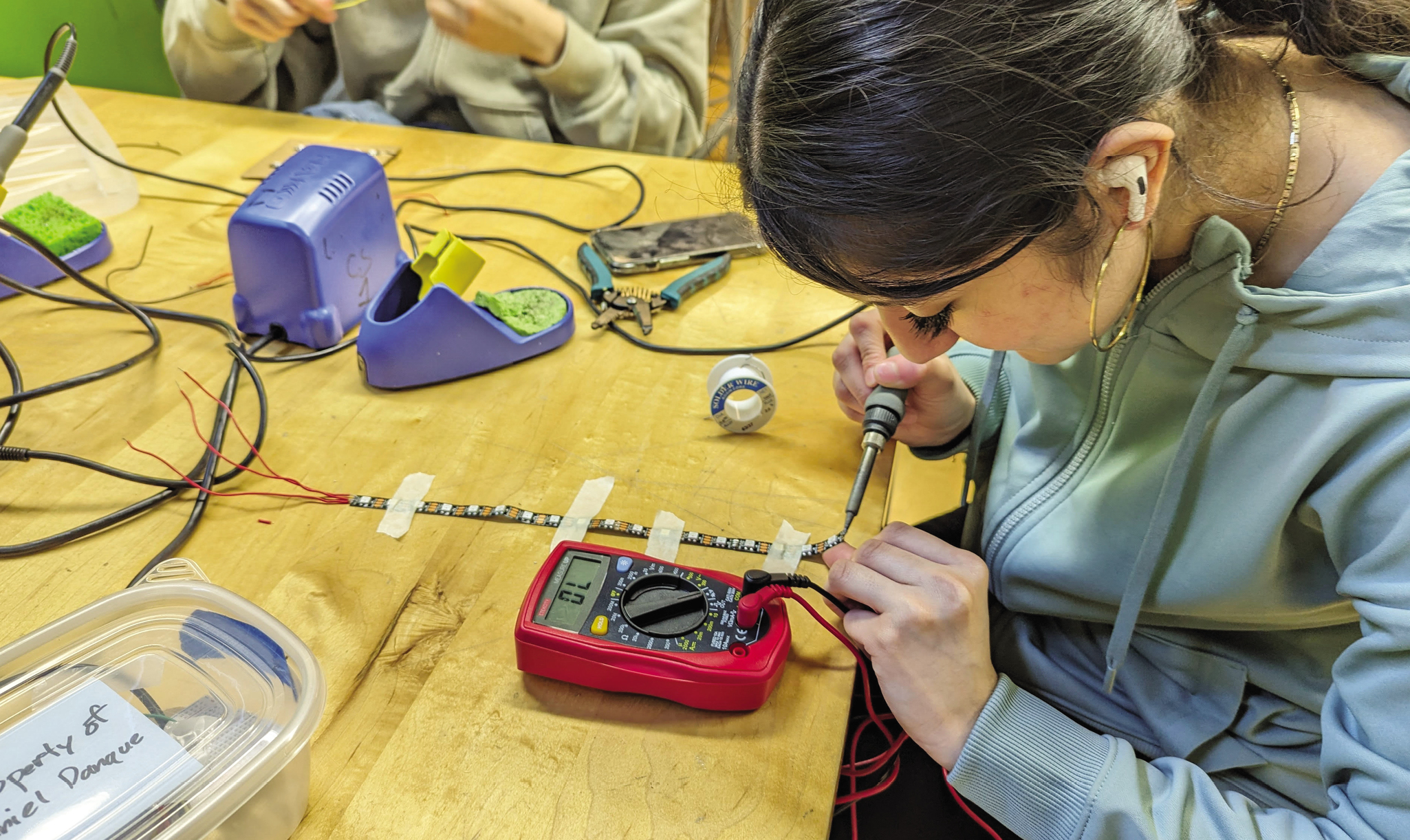Momentum Building for Computer Science
August 01, 2024
A story of three school districts’ full instructional embrace of the subject across all grade levels

After searching on Long Island, N.Y., for years, Kuri DiFede in 2016 finally landed a job as computer science teacher at Mineola High School. In her first year, DiFede, 37, with a master’s degree in computer science, taught electives that drew a handful of students, including just three for her Advanced Placement class.
Today, eight years later, she works in a high school computer science department with three other teachers, two with degrees in the subject. The school requires all 200 freshmen to take AP Computer Science Principles and enrolls about 150 students in other computer science electives.
The experience of DiFede and her school reflects the dramatic expansion of computer science in U.S. public schools, with many now scrambling to find teachers with her expertise.
“Our world is not going to be the same,” DiFede says.
Slow Enrollment Gains
The landmark “A Nation at Risk” report by the federal government in 1983 recommended all high schools make computer science one of what it called “Five New Basics” required of all students for at least a semester.
Yet it wasn’t until 2017 that Nevada became the first state to pass legislation requiring computer science for a high school diploma. At the time, only about a third of high schools nationwide offered the subject and only four states required them to offer computer science, according to the “2023 State of Computer Science Education,” a report produced by the nonprofit Code.org and two other national groups promoting computer science education.
By the start of 2023-24, 29 states required schools to offer computer science, eight adopted laws to mandate it for graduation and about a dozen were considering the diploma requirement. The share of high schools offering computer science courses rose to 58 percent, the biggest annual increase in five years, the report says.
Still, only 6 percent of high school students in 35 states where data are available enrolled in a computer science course last year.
Staffing Limits
Computer science teaches students how to create computer technology, not just use it. They learn how to code and use algorithms to program, make websites, design games, move robots, analyze data and solve problems. And more are studying increasingly prominent artificial intelligence.
Every student needs to know computer science, says Jake Baskin, executive director of the 20,000-member Computer Science Teachers Association.
Daniel Law, a veteran teacher at Lane Tech College Prep High School in Chicago, says, “When kids get really good in this field, they are naturally going to be better in other fields such as math, biology and physics,” an observation supported by a meta-analysis of 440 studies, according to Hadi Partovi of Code.org.
Significant challenges stymie the subject’s growth in high school classrooms. Computer science teachers are in short supply. While four in five students have access to computer science instruction, it remains particularly scarce in small and low-income schools, disproportionately affecting rural, Native American, Latino and Black students, says Sean Roberts, vice president of U.S. strategy for Code.org. A computer science gender gap remains, too, he says, with girls making up only about 30 percent of enrolled students.
Code.org recommends schools offer computer science in elementary and middle schools and require it for graduation, practices that would expose it to all girls and minority groups.
In some school districts on the leading edge — such as Chicago Public Schools, Teton County in Wyoming and Mineola on Long Island — all students take computer science. With qualified teachers scarce, these three districts found ways to train their own instructional staff.
Chicago Public Schools
In 2016, Chicago made computer science a graduation requirement for its more than 100 public high schools. “That was the only way we could ensure equity,” says Kristan Beck, director of computer science in the district’s Office of Teaching and Learning.

The district’s computer science offerings had been spotty and mostly available in schools serving higher-wealth neighborhoods when in 2008 a group of Chicago’s school administrators set out to give all students access. They sought gender and racial equity as they adopted a curriculum with the help of computer science and education researchers from a variety of universities. They also consulted with the Los Angeles Unified School District. Using patience and compassion, Beck says, the district persuaded more than 1,000 of its teachers to participate in training for computer science.
“We’ve been able to grow because teachers trust us,” Beck says.
Today, she leads a central-office department of 19 technical and content specialists helping the district provide computer science education at every level. Of the 477 Chicago K-8 schools, 260 offer some computer science education. All high school students must take Exploring Computer Science to graduate, and more than half of the high schools offer additional computer science electives, including AP courses.
At Lane Tech, a selective enrollment magnet high school on the north side of Chicago, about 2,000 of the 4,600 students are studying computer science in 13 courses offered by 14 teachers, says Law, chair of the computer science department and a teacher for 21 years. Lane Tech offers a range of classes up to college-level instruction on game design, Java and Python coding, mixed media, robotics and more, Law says. Students work on projects in a well-equipped makerspace lab.
In one project conducted in his physical computing class, Law pairs his students with those from honors art. Each pair designs a sculpture that’s programmed to change daily based on information it collects. Two students created a volcano that blasts fake steam before a backdrop of stars. The steam changes height and the stars change colors according to pollution data the volcano pulls daily.
Some elementary principals hesitated to offer computer science for lack of a trained teacher or time in the school day, Beck says. So the district won a grant to train teachers in 15 pilot schools to provide after-school computer science for extra pay.
In every case, Beck says, those schools eventually made computer science part of their regular school day.
Teton County School District
The nearly 3,000-student Teton County School District based in Jackson, Wyo., requires children to take computer science every year from kindergarten through middle school. More than 100 high school students also choose advanced computer science courses.
Bordered by the Teton Mountains, the rural district encompasses an unusually wealthy area. English is a second language for about half its students, whose parents work in service occupations for the Jackson Hole ski resort industry.
The high-performing district has offered computer science for more than a decade. But it did not formally coordinate its curriculum until six years ago when Wyoming mandated all schools include computer science and computational thinking in the curriculum, says superintendent Gillian Chapman, who took charge of the district in 2015.
With state money, the district tapped its sole computer science teacher to train more of its teachers. Wyoming allocates districts 20 percent of their elementary teacher revenue for instructors in areas such as music and art, so Teton County taps into those funds to support computer science teachers.
Elementary students leave class for computer science twice a week just as they do for art and music, says Chapman, Wyoming’s 2023 Superintendent of the Year. Middle school students also all study the subject. Robotics teams thrive at all levels.
By the time they reach Jackson Hole High School, students are well prepared for three AP computer science sections taught by Carl Shuptrine, also a digital media arts teacher at the 900-student school. The subject is as critical as math, science or language arts, he says. It “underpins everything a student is going to touch in our modern society.”
In Samantha Smith’s three digital fabrication labs, students learn coding to control switches, sensors, laser cutters, 3D printers and more as they design things such as glowing sculptures. Students also occasionally encounter computer science in her bioengineering courses.
Districts seeking a robust computer science program should start by finding “somebody who has a passion” for it, Chapman says. “You turn them loose. You say, ‘Dream big and let’s make this happen for our kids.’”
Mineola Public Schools
Dreaming big is what Superintendent Michael Nagler did in 2016 when he hired Kuri DiFede as the first computer science teacher for Mineola Public Schools. As she organized the high school’s program, a district committee explored ways to offer computer science in all grades, beginning in its two preschools.
The committee essentially back-planned what had to happen to prepare students for a college-level AP computer science course by the time they reached 9th grade, says Nagler, superintendent for 15 years. “We think every student should be well-versed in computational thinking, design thinking and coding.”

The affluent, high-performing suburban Long Island district enrolls about 3,000 students, nearly half white, a third Latino and the rest Asian and other minorities. It hired a private nonprofit, kidOYO, to train and mentor teachers and to build a website platform where students and teachers can learn coding and other skills on their own.
The school district encourages teachers at all levels to infuse computer science into their lessons. A science teacher might help students use coding to draw parts of a cell, says Nicole Culella, who oversees the district’s computer science education.
Lessons begin in preschool. Diane Nodell, media specialist at Hampton Street School, shows preschoolers how to program a Bee-Bot, a motorized bumble bee toy on wheels. They press buttons on its back in various sequences to make the bot go where they want. “Through manipulation and play, they are learning the basic concepts to apply toward all programming,” she says.
Julia Manevitz, a rising senior at Mineola High, became hooked on computer science in 3rd and 4th grades by using Python code to manipulate a turtle on a screen. “It was very interesting that some simple text can cause the turtle … to move or to draw a circle,” she says.
In middle school, Manevitz took a college-level course independently to learn more about Python coding. In high school, she’s learned Java programming, independently studied web design, built a database for other computer science learners and joined the school’s robotics team. The district provided all of her independent and classroom courses. Not surprisingly, Manevitz wants to study computer science in college.
DiFede says she was halfway through college before she discovered computer science. Had she attended school in Mineola district, she noted, she would have been like Manevitz and plunged much earlier in life into the field she loves. n
BILL GRAVES is a freelance education writer in Beaverton, Ore.
Author
Additional Resources
Several national organizations work with schools and districts to spread computer science education.
Code.org. A nonprofit that brings together more than 100 industry, nonprofit and advocacy organizations to spread computer science in K-12 education.
Computer Science Teachers Association. A professional organization preparing K-12 teachers.
CSforALL. A consortium of computer science groups, including the College Board and the National Center for Women & Information, to support high-quality computer science.
Expanding Computing Education Pathways Alliance. Identifies policies, pathways and practices in state education systems.
Microsoft Computer Science Education. Microsoft partners with nonprofits and educators globally to equip youth with digital skills.
National Center for Women & Information Technology. A network of change leaders focused on correcting underrepresentation in computing.
Advertisement
Advertisement
Advertisement
Advertisement




